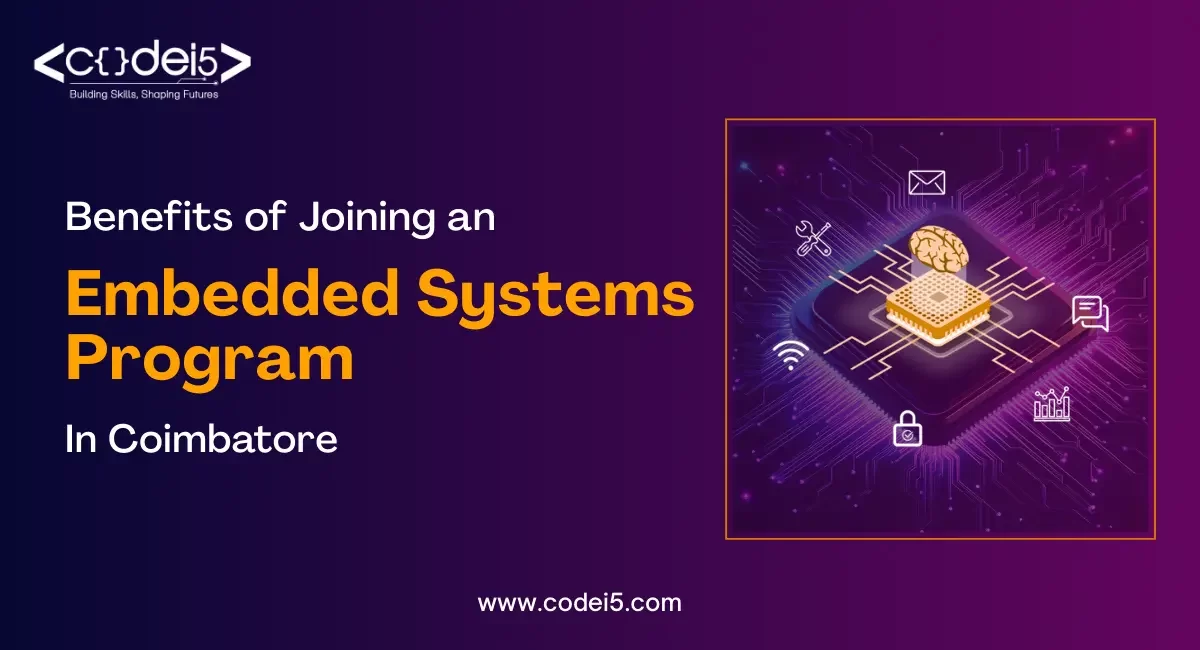
The robotics industry is growing fast. From driverless cars and automated warehouses to surgical robots and space explorers, these machines are changing our lives in big ways. But what makes these amazing machines work? The answer is Embedded C Programming.
While exciting artificial intelligence (AI) programs often grab the headlines, the real hero behind most robots is embedded C. This programming language allows robots to talk directly to their hardware, helping them sense their surroundings, make smart choices, and carry out actions.
So, the question is: Does learning embedded C programming lead to a great career in robotics?
Let’s dive into the world of embedded systems and find out what exciting opportunities it offers.
Understanding Embedded C Programming
Embedded C is a variant of the C programming language specifically designed for microcontrollers, the tiny computers found in robots and other electronic devices. Unlike general-purpose C used for desktop applications, embedded C prioritizes:
- Efficiency: Embedded systems often have limited resources, so code needs to be tight and use memory efficiently.
- Real-time Performance: Robotics often involves critical tasks that need to happen instantly. Embedded C ensures precise control over hardware for real-time responsiveness.
- Hardware Interaction: Embedded C allows programmers to directly interact with a robot’s sensors, motors, and other components.
Why Choose Embedded C?
Unlike your laptop or phone, robots need to react instantly. This fast-moving world requires a language that is both precise and efficient. Embedded C is perfect for this. Here’s why:
- Direct Hardware Control: Embedded C lets you talk directly to a robot’s microcontrollers, which are the tiny brains that control its movements and sensors. This detailed control is crucial for fine-tuning how a robot behaves.
- Efficiency is Key: Embedded systems often have limited resources. Embedded C is known for its efficient use of memory and processing power, making it ideal for situations where every bit of data matters.
- Rock-Solid Reliability: Robots need to be trustworthy and consistent. Embedded C’s predictable behavior and well-established development tools ensure that your code runs smoothly, mission after mission.
The Role of Embedded C in Robotics
As mentioned earlier, embedded C forms the foundation for a robot’s functionality. Here’s a breakdown of its key roles:
- Sensor Data Acquisition: Embedded C programs read data from various sensors like LiDAR, cameras, and accelerometers, allowing the robot to perceive its surroundings.
- Motor Control: It translates high-level commands into precise instructions for the motors, enabling the robot to move and interact with its environment.
- Real-time Processing: Embedded C programs ensure critical tasks happen instantaneously. This is vital for functions like obstacle avoidance or maintaining balance.
- Decision-Making: Based on sensor data, embedded C programs can make basic decisions within pre-defined parameters. This allows robots to react to situations without constant human intervention.
Benefits of Learning Embedded C for Robotics
By learning embedded C, you open up many opportunities in the robotics field:
- In-Demand Skill: The demand for skilled embedded C programmers is growing as the robotics industry expands.
- Hardware Expertise: You’ll understand better how robots interact with the physical world through their hardware.
- Strong Foundation: Knowledge of embedded C gives you a solid base for learning more advanced robotics concepts like control systems and robot operating systems (ROS).
How to Begin with Embedded C for Robotics?
If you’re excited to start, here’s a guide to help you begin:
- Learn C Programming Basics: Make sure you understand fundamental C concepts like variables, data types, and control flow statements.
- Understand Microcontrollers: Get familiar with the architecture and functions of microcontrollers commonly used in robots. Arduino is a beginner-friendly platform to start with.
- Use Embedded C Development Tools: Learn how to use Integrated Development Environments (IDEs) designed for embedded systems programming.
- Practice with Robotics Kits: Many starter kits come with microcontrollers and sensors, allowing you to experiment with embedded C programming in a practical robotics setting.
- Enroll in Codei5 Academy’s Embedded C Course: Consider enrolling in Codei5 Academy’s Embedded C course to deepen your understanding and skills in embedded C programming for robotics.
Essential Tools for Embedded C Programming in Robotics
Here are some important tools you’ll use in your robotics adventure:
- IDEs (Integrated Development Environments): Programs like Keil MDK-ARM or Eclipse with CDT help you write, compile, and fix errors in your embedded C code.
- Compilers: These tools change your C code into machine code that the robot’s microcontroller can understand.
- Debuggers: They’re crucial for finding and fixing problems in your embedded C programs.
- Simulators: These let you test and fix your code in a pretend world before trying it on the real robot hardware.
Future Trends in Robotics and Embedded C
The future of robotics is full of exciting possibilities:
- AI Integration: Embedded C will work alongside AI algorithms, helping robots make complex decisions and perform advanced tasks.
- Internet of Things (IoT): Robots will be more connected, requiring embedded C programs to manage communication and data exchange.
- Security Enhancements: As robots get more advanced, embedded C will help protect them from cyber threats.
Is Embedded C the Only Key?
While embedded C is crucial for robotics, it’s not the only thing to focus on:
- Robotics Frameworks: Learning frameworks like ROS (Robot Operating System) will help you build advanced robotic functions.
- Object-Oriented Programming (OOP): OOP concepts can manage complex code in big robotics projects.
- Artificial Intelligence (AI): Understanding AI will be important as robots get smarter and more independent.
Getting Started
The world of robotics is waiting! If you love making smart machines, start by learning embedded C. With practice and learning, you can have a rewarding career in this fast-changing field.
At Codei5 Academy, we often host robotics workshops where you can learn hands-on. These workshops are a great start for your robotics journey in a fun and team-friendly setting.
So, don’t wait! Start learning embedded C and other robotics skills. Get ready to shape the future of robotics! Codei5 Academy is here to support you all along the journey.
Conclusion
While knowing embedded C programming isn’t the only thing for a robotics career, it’s really important. By learning this language well, you can make robots work, solve big problems, and be part of cool new technologies.
If you’re interested in a robotics career, think about learning embedded C programming. It could open up a world of amazing opportunities!







